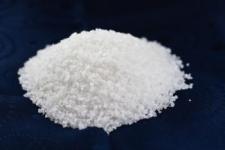| Back to Back Issues Page |
 |
|
The Goldfish Gazette, Issue #015 -- Goldfish Medications and How To Use Them Safely March 30, 2015 |
Goldfish Care Tips and GuidelinesA Free Monthly Resource For Goldfish Enthusiasts In this issue
Even if Goldfish are given the best possible care, sometimes due to injury or introduced disease we must take action to remedy the situation. Goldfish Medications and How To Use Them Safely
The safest medication to treat many Goldfish ailments is plain un-iodized salt. It is very hard to overdose goldfish with salt, especially if it is added to their water gradually. Iodine is added to table salt to stop humans forming goiters, a medical condition that causes swelling of the thyroid gland in the neck. Iodine is poisonous to Goldfish so you want to get salt that hasn't had iodine added. The easiest source is the local food market where it will be sold as plain cooking salt. The salt crystals should be fairly coarse, and it should be free of any additives such as a pouring agent which is added to salt to make it dispense or pour more easily. There are many other sources if you need larger quantities. I used to buy mine in 25kg (55 lb) sacks from a local swimming pool company that sell it as swimming pool salt. Salt should always be added to the water of sick fish as it seems to act as a tonic. Salt is particularly helpful for fish that have been injured and the abdomen area punctured. The internal salinity of a fresh water fish is greater than the surrounding water. If the abdomen cavity is punctured, the bodily fluids leach out of the fish which will cause a chemical imbalance and quickly lead to death. Identify The Disease CauseBefore attempting to cure any disease, you need to broadly identify what the Goldfish is suffering from. It will be one of three possibilities: 1. Fungal attack 2. Bacterial attack 3. Parasitic attack. There is also the possibility that the fish could be suffering from more than one ailment if it is very sick. You need to have an idea what the disease is because it will dictate what you treat your fish with and the dosage. If we use salt as an example of a possible medication for the three ailments above, for a fungal attack a lot of salt needs to be added to the water to be effective. There are better medications that are more effective. For a bacterial attack, salt is very effective even in low concentrations. For a parasitic attack salt is ineffective unless used as a dip at very high concentrations. The fish has to be able to withstand this kind of shock treatment. Again there are better treatments available. Under Dose Rather Than Over DoseBy the time you discover your fish is sick, and this applies especially to pond fish that may not be seen daily, the disease can be fairly advanced before you notice it.Move the fish into a sickbay filled with water the fish was in. Test the water pH level and ammonia level if you can. This gives you an idea whether the water is the cause of the problem. If it is, change 50% of the water, adding Stress Coat® to get rid of any chlorine. I can't recommend Stress Coat® strongly enough. Apart from removing heavy metals and chlorine from the water, it replaces the natural protective slime coating that fish use as a defense against disease and parasites. Add a little salt to the water. Now observe the fish to see if you can identify the cause of the disease. If it isn't obvious such as a fungal attack, change 50% of the water and leave the fish in the mild salt bath for 24 hours. If the fish responds to this treatment and feeds, increase the salt concentration slightly and do nothing else until all signs of the disease are gone, it is feeding well, and all fins are being held erect. If the fish doesn't respond to this treatment it is probably a parasite attack which will involve treatment with a Praziquantel based tablet or powder. How Sick Is The Patient?You need to work out how sick the fish is by its activity level. If it sits on the bottom or gasps at the surface continuously, you have a very sick fish. I would leave it in the mild salt bath for a few hours or until its activity level increases. I would then use half the treatment level recommended by the treatment supplier until the fish starts to become more active. When treating fish with any chemical, you need to closely observe them for a few hours. It the fish starts to lie on its side, the treatment is too strong. Remove the fish from the treatment completely, let it recover then halve the dose before trying again. To read more on the treatment of Goldfish diseases click here... Comments? Ideas? Feedback? I'd love to hear from you. Just reply to this e-zine and tell me what you think, or what topics you want covered. Next Month's Topic Goldfish pond maintenancewww.facebook.com/aboutgoldfish |
| Back to Back Issues Page |